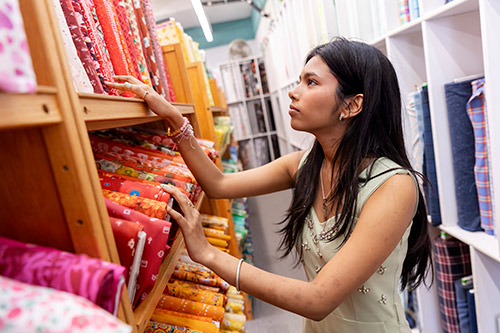
When it comes to her far-reaching interests, Deshna Desai LL.M. ’24 takes a pedal-down approach.
During her law school studies in Mumbai, India, Desai’s impressive list of internships spanned trademarks, litigation, media and entertainment law, real estate regulation, children’s rights, adjudication, and more. At Berkeley Law, she is active with the school’s Art and Innovation Representation pro bono project, Berkeley Global Society, Sports and Entertainment Law Society, Berkeley Journal of Entertainment & Sports Law, and Samuelson Law, Technology & Public Policy Clinic.
While pursuing a specialization in Law and Technology, Desai has also cultivated a surging interest in how fashion and law intersect. A self-proclaimed fashion fanatic, she recently published an article in the Fashion & Law Journal, a leading outlet for legal insights in the fashion industry, about the psychological factors that draw consumers to luxury clothing items.
Below, Desai describes some of the compelling aspects, important nuances, and timely issues that exist at the nexus of law and fashion.
The fashion industry is a place of expression, creativity, and invention. It is a multimillion-dollar field that sets global trends, molds civilizations, and has a profound impact on societies.
However, designers, companies, and customers must navigate a complicated web of legal challenges and restrictions that lay behind the beauty and attractiveness of this intriguing industry. This is best done by addressing the connection between law and fashion, emphasizing the vital role that legal frameworks play in forming and safeguarding this ever-evolving sector.

Intellectual property (IP) rights form a major junction between fashion and law. Designers in particular rely heavily on IP regulations to keep their works safe from imitation or copying.
While specific components of fashion, such as fabric prints, graphic designs, and logos, may be protected by copyright in the United States, fashion designs themselves are not. In the fashion business, trademarks are especially important because they prevent third parties from using brand names, logos, and other identifiers in a way that can mislead customers.
The necessity to safeguard fashion designs under copyright law has come to be more widely acknowledged in recent years. The ideal method to strike a balance between the need for protection and the desire for innovation and originality has been the subject of discussions and arguments across the legal and fashion communities.
Human rights and labor law are two other key areas where fashion and law intersect. The fashion business is infamous for using cheap labor, frequently from poor nations with inadequate protections for workers’ rights. Urgent calls for more transparency and accountability in the sector have emerged from this, and many businesses are currently under pressure to make sure that their supply chains are free from exploitation and abuse.
Sectors of the fashion industry have been attempting to improve working conditions in recent years, and certain firms have made commitments to fair labor standards and ethical sourcing. But there are still difficulties in the business, and problems like forced labor, child labor, and hazardous working conditions remain present.

Environmental sustainability is yet another field where law and fashion converge. The fashion business has been one of the most environmentally damaging sectors of the global economy, with an enormous influence on the environment at every point of the supply chain, from manufacture to disposal. As a result, we see a growing trend in fashion toward sustainable designs and businesses that emphasize environmentally friendly materials and production techniques.
To promote environmental sustainability in the fashion sector, strong legal frameworks are essential. Sustainable behaviors like recycling, upcycling, and using renewable energy sources can be encouraged by laws and regulations. Additionally, such frameworks can ensure that businesses accept responsibility for the trash and pollution they produce by holding them accountable for their effects on the environment.
The connection between fashion and law is only getting stronger. Legal structures are essential to the shaping and regulation of the fashion industry, encompassing everything from IP rights and labor to human rights and environmental sustainability.
Designers, brands, and legislators must collaborate as the fashion industry develops and grows to guarantee that fashion remains a vehicle for originality, creativity, and constructive change.